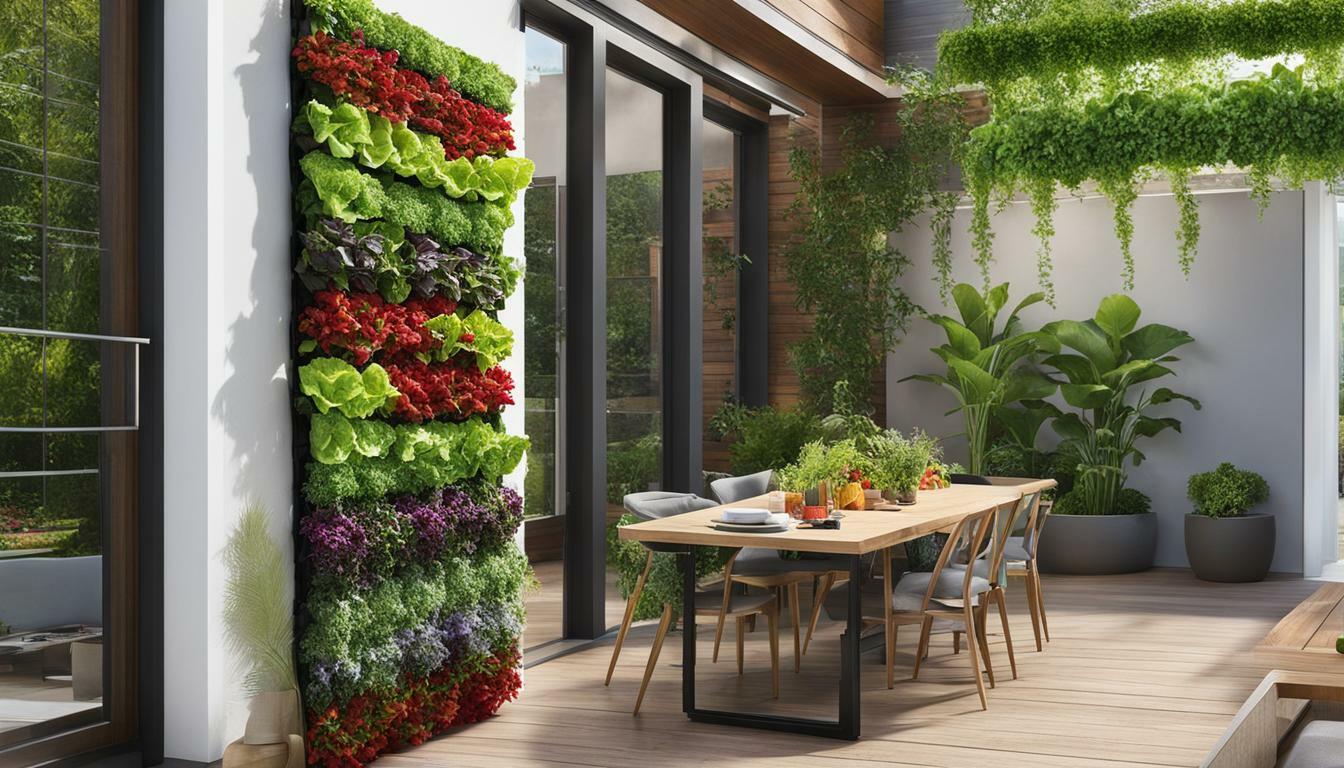The Efficiency of Vertical Gardening
Vertical gardening offers a solution for gardeners with limited space, allowing you to make the most of your available area and achieve higher yields than traditional gardening methods. By utilizing vertical space, you can grow a variety of plants, including vegetables, herbs, and flowers, even in small gardens or urban settings.
One of the main benefits of vertical gardening is maximizing space. Instead of plants spreading out horizontally, they grow upwards, taking advantage of walls, trellises, and other structures. This efficient use of vertical space allows you to grow more plants in a smaller area, making it perfect for those with limited space.
In addition to maximizing space, vertical gardening also offers other advantages. When plants are lifted off the ground, they are less susceptible to diseases and pests, as there is better air circulation around the foliage. This can reduce the need for chemical interventions and make maintenance easier.
There are various vertical gardening techniques and structures that can be used to create a successful vertical garden. Wall planters, composting vertical garden planters, vertical garden beds, and stackable planters are just a few examples. Each of these options provides a unique way to grow plants vertically and can be tailored to suit your specific gardening needs and preferences.
By embracing vertical gardening, you can transform your space into a lush and productive garden, even with limited room. Whether you’re growing lettuce, tomatoes, or flowers, vertical gardening offers an efficient and space-saving solution that allows you to enjoy the benefits of gardening regardless of the size of your space.
| Benefits of Vertical Gardening | Maximizing Space with a Vertical Lettuce Garden |
|---|---|
|
|
Vertical gardening offers an efficient and space-saving solution that allows you to enjoy the benefits of gardening regardless of the size of your space.
The Garden Tower for space-saving vertical gardens
The Garden Tower is a versatile and efficient vertical garden planter that allows you to grow up to 50 plants in just four square feet of space. It features a built-in composter for kitchen scraps, making it a sustainable and eco-friendly option. With its self-watering design and multiple pockets for planting, the Garden Tower is a great choice for small spaces and limited areas.
Another option for vertical gardening is the use of wall planters. These self-watering planters come with multiple pockets and baskets, allowing you to plant a variety of vegetables, herbs, or flowers. They can be hung on outdoor fences or walls inside your home, creating a stunning wall of greenery and expanding your garden space.
Stackable planters are also a popular choice for vertical gardening. These trays with multiple planting spots can be stacked on top of each other, creating a large strawberry pot-like structure. They are perfect for growing strawberries or other plants, and most come with a drip tray, making them suitable for indoor or outdoor use.
Choosing the Best Lettuce Varieties for Vertical Gardens
When choosing lettuce varieties for vertical gardens, it’s important to consider their growth habits and suitability for vertical growth. Lettuce varieties with a short root system or those that like to climb are ideal for vertical gardening.
Some recommended lettuce varieties for vertical gardens include:
- Lollo Rossa
- Red Oakleaf
- Buttercrunch
- Romaine
- Little Gem
These varieties have compact growth habits and can thrive in vertical gardening systems. They are also known for their delicious flavor profiles, making them a great choice for fresh salads and sandwiches.
Designing Your Vertical Lettuce Garden
Designing your vertical lettuce garden allows you to create a visually appealing and functional space. There are various design ideas to consider, including different types of planters, trellises, and structures that can be used to support your vertical garden.
Some popular design ideas for vertical lettuce gardens include:
- Using trellises and arbors for a structured garden
- Repurposing old items like bicycles, wagons, or fences for a unique garden
- Using creative structures and repurposed items for aesthetic appeal
By exploring different design ideas, you can create a vertical lettuce garden that not only maximizes space but also adds beauty and interest to your outdoor or indoor area.
Tips for Successful Vertical Lettuce Gardening
Successfully growing lettuce in a vertical garden requires proper care and attention. Here are some tips to help you achieve success:
- Ensure your vertical garden receives adequate sunlight for lettuce growth
- Water your lettuce regularly, providing enough moisture to keep the soil evenly moist but not waterlogged
- Fertilize your plants with a balanced fertilizer to promote healthy growth
- Monitor for pests and diseases and take appropriate measures to control them
- Regularly harvest lettuce leaves to encourage continuous growth
By following these tips, you can ensure the success of your vertical lettuce garden and enjoy a bountiful harvest of fresh, homegrown lettuce.
Maximizing Space with Vertical Lettuce Gardening
One of the key advantages of vertical gardening is the ability to maximize space. Vertical lettuce gardening allows you to grow more plants in a smaller area, making it ideal for those with limited space or small gardens. By utilizing vertical structures such as trellises, wall planters, or stackable planters, you can make the most of your available space and grow a diverse range of lettuce varieties.
With vertical gardening, you can transform even the smallest of spaces into a productive and beautiful garden.
Creative Vertical Lettuce Garden Structures
When it comes to designing your vertical lettuce garden, you can get creative with the structures and items you use. Repurposing old items like bicycles, fence panels, or wagon wheels can add a unique touch to your garden. These structures can be used as supports for climbing vegetables or as decorative focal points in your garden.
Experimenting with different structures and materials can help you create a one-of-a-kind vertical lettuce garden that showcases your creativity and style.
Conclusion
Vertical gardening offers a space-saving and efficient solution for gardeners with limited space. By growing plants vertically, you can maximize your available area and achieve higher yields than traditional gardening methods. Whether you choose to use wall planters, stackable planters, or other vertical gardening techniques, you can transform your space into a lush and productive garden. With the right lettuce varieties, proper care, and attention, you can enjoy a bountiful harvest of fresh, homegrown lettuce while making the most of your space.
Getting Started with a Vertical Lettuce Garden
Starting a vertical lettuce garden is easier than you might think, and with a few simple steps, you can be on your way to growing your own fresh lettuce at home. Vertical gardening is a great way to maximize your space and increase your yields, especially if you have limited garden space.
There are several techniques you can use to start a vertical lettuce garden. One option is to use vertical garden planters, such as composting vertical garden planters or wall planters. These planters allow you to grow a variety of plants, including lettuce, in a small space. They typically have multiple pockets or baskets for planting, and some even have built-in composters for kitchen scraps.
Another option is to use vertical garden beds or stackable planters. Vertical garden beds are similar to flower boxes but stacked vertically on a stand or frame. They can be made of wood or plastic and may have drip irrigation systems for easier gardening. Stackable planters are trays with multiple planting spots that can be stacked, creating a large strawberry pot-like structure. They are perfect for growing lettuce and other plants vertically.
Table: Comparison of Vertical Lettuce Garden Structures
| Structure Type | Features | Suitable Plants |
|---|---|---|
| Vertical Garden Planter | Versatile, space-saving, built-in composter | Lettuce, fruits, vegetables, herbs |
| Wall Planter | Self-watering, multiple pockets and baskets | Lettuce, flowers, herbs |
| Vertical Garden Bed | Stacked flower box-like structure, drip irrigation system | Lettuce, vegetables, flowers |
| Stackable Planters | Tray with multiple planting spots, drip tray included | Lettuce, strawberries, various plants |
Once you have chosen the right structure for your vertical lettuce garden, it’s time to prepare the soil and plant your lettuce. Make sure to choose a location that receives at least 6 to 8 hours of direct sunlight per day. Prepare the soil by removing any weeds or debris and adding organic matter, such as compost or well-rotted manure, to improve soil fertility.
When planting the lettuce, make sure to space the plants adequately to allow for proper air circulation and growth. Follow the instructions on the seed packet or transplant label for specific spacing recommendations. Water the lettuce regularly and monitor for pests or diseases. Proper watering, fertilization, and pest control are essential for successful vertical lettuce gardening.
With these techniques and tips, you can transform your space and create a thriving vertical lettuce garden. Whether you choose a vertical garden planter, wall planter, vertical garden bed, or stackable planters, vertical gardening allows you to maximize your space and grow more lettuce in a limited area. Start your vertical lettuce garden today and enjoy the fresh, homegrown lettuce all season long.
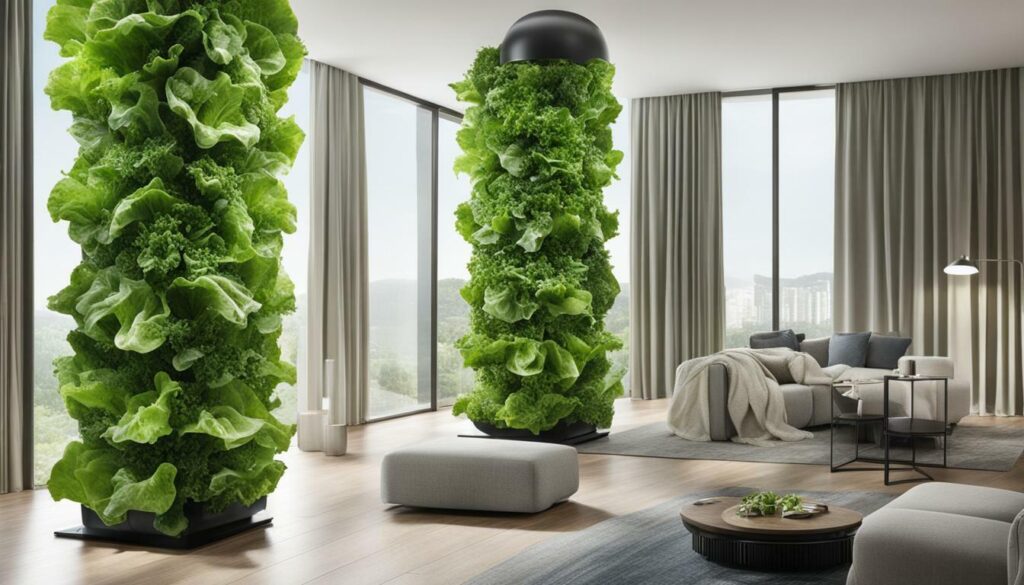
Choosing the Best Lettuce Varieties for Vertical Gardens
When selecting lettuce varieties for your vertical garden, it’s important to choose varieties that will thrive in a vertical growing environment and provide you with the flavors and textures you desire. With the right lettuce varieties, you can enjoy a bountiful harvest and maximize the space in your garden.
Lettuce Varieties for Vertical Gardens
Here are some excellent lettuce varieties that are well-suited for vertical gardens:
| Lettuce Variety | Growth Habit | Flavor |
|---|---|---|
| Bibb Lettuce | Compact, rosette | Tender and sweet |
| Romaine Lettuce | Tall, upright | Crunchy and slightly bitter |
| Butterhead Lettuce | Loose, buttery leaves | Soft and mild |
| Leaf Lettuce | Loose, leafy growth | Variety of flavors (mild to spicy) |
| Microgreens Lettuce | Tiny, delicate leaves | Intense and concentrated |
Each of these lettuce varieties has its own unique characteristics and growing requirements, so it’s important to choose varieties that align with your preferences and gardening conditions. Experiment with different varieties to find the ones that thrive in your vertical garden setup.
“With the right lettuce varieties, you can enjoy a bountiful harvest and maximize the space in your garden.”
In addition to these varieties, there are also several lettuce mixes available that contain a combination of different lettuce types, providing a variety of flavors and textures in one planting. These mixes are great for vertical gardens as they offer a diverse range of lettuces in a compact space.
Remember to consider the growing requirements of each lettuce variety, including the amount of sunlight, water, and nutrients they need. Proper care and attention will help ensure that your vertical lettuce garden thrives and produces a plentiful harvest.
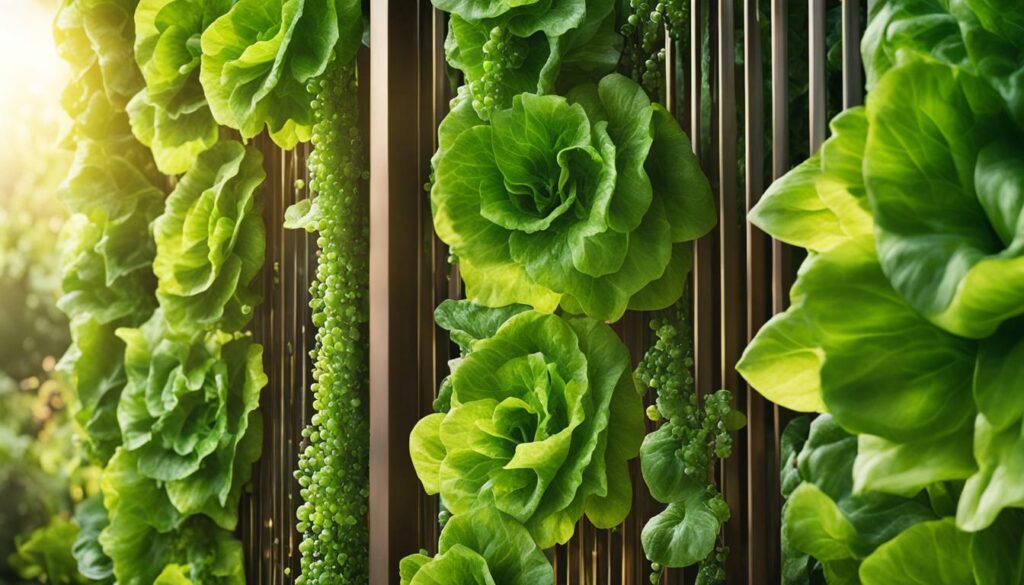
By choosing the best lettuce varieties for your vertical garden, you can create a vibrant and productive space that maximizes your gardening potential. Whether you prefer tender and sweet Bibb lettuce or crisp and crunchy Romaine lettuce, there is a lettuce variety out there that will thrive in your vertical garden and provide you with delicious, homegrown greens.
Designing Your Vertical Lettuce Garden
Designing your vertical lettuce garden is an opportunity to get creative and incorporate functional and aesthetic elements that suit your space and personal style. Vertical gardening allows you to make the most of limited space and transform your environment with lush greenery. Whether you have a small balcony, a backyard, or even an indoor space, there are various design ideas that can help you create a beautiful and productive vertical lettuce garden.
One versatile option for vertical gardening is the use of vertical garden planters. These planters come in different styles, but one of the most versatile options is the composting vertical garden planter. With this planter, you can grow up to 50 plants, including lettuce, fruits, vegetables, and herbs, even in small spaces. It also has a built-in composter for kitchen scraps, making it an eco-friendly choice.
Wall planters are another popular choice for vertical lettuce gardens. These self-watering planters have multiple pockets and baskets, allowing you to plant a variety of lettuce and other crops. They can be easily hung on fences or walls, both indoors and outdoors, creating a stunning wall of greenery.
If you prefer a more traditional approach, vertical garden beds are a great option. These garden beds are stacked vertically on a stand or frame, similar to flower boxes. They can be made of wood or plastic, and some even come with drip irrigation systems for easier gardening.
For a unique and creative vertical lettuce garden, consider repurposing items or using creative structures. Old bicycles, antique tillers, and wagon wheels can all be used to add visual appeal to your garden. You can also repurpose old fences or pieces of chain link to create trellises and other garden structures. The possibilities are endless, and your imagination is the limit.
Table: Best Lettuce Varieties for Vertical Gardens
| Lettuce Variety | Growth Habit | Flavor Profile |
|---|---|---|
| Butterhead | Forms loose heads, good for small spaces | Mild and buttery |
| Romaine | Tall and upright, great for vertical gardens | Crunchy and slightly bitter |
| Leaf Lettuce | Does not form heads, grows well in tight spaces | Tender and slightly sweet |
| Looseleaf | Forms loose clusters of leaves, good for vertical gardens | Mild and delicate |
When designing your vertical lettuce garden, it’s important to choose the right varieties of lettuce that are well-suited for vertical growth. Lettuce varieties such as Butterhead, Romaine, Leaf Lettuce, and Looseleaf are great choices for vertical gardens due to their growth habits and flavors. Consider mixing different varieties to add visual interest and variety to your garden.
With the right design ideas and lettuce varieties, you can create a stunning and productive vertical lettuce garden that maximizes your space and enhances the beauty of your surroundings. Whether you choose vertical garden planters, wall planters, or repurposed items, let your creativity flourish and enjoy the abundance of fresh lettuce right at your fingertips.
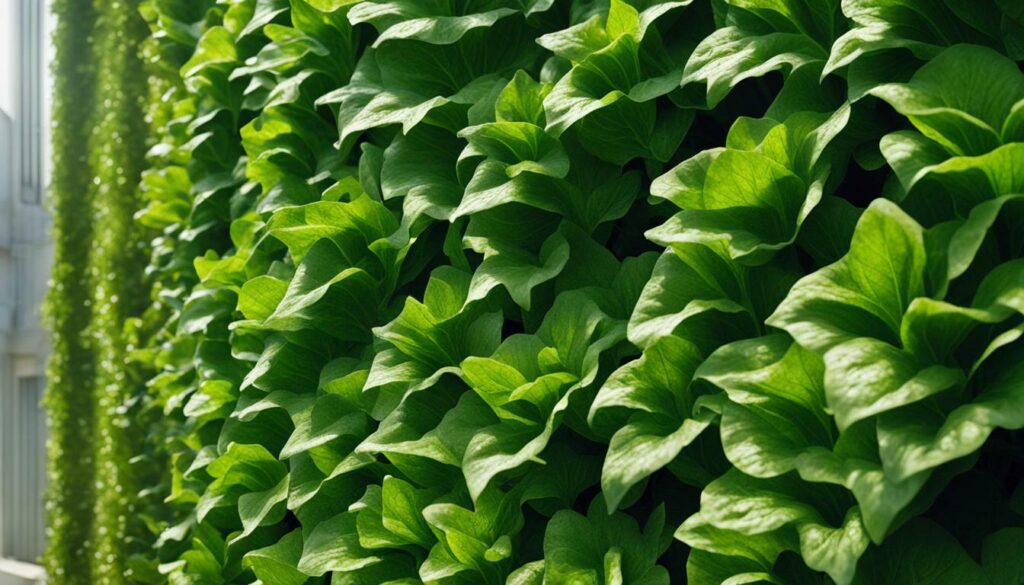
Sources: Joy Us Garden , Garden Tower Project
, Garden Tower Project , The Spruce
, The Spruce
Tips for Successful Vertical Lettuce Gardening
To ensure a successful harvest of fresh lettuce from your vertical garden, there are certain tips and techniques that can help you achieve optimal results. Vertical gardening offers a space-efficient way to grow lettuce and other plants, maximizing your growing area and increasing yields. Here are some tips to help you get started and maintain a successful vertical lettuce garden.
Proper Watering and Fertilization
Watering is crucial for the health and growth of your lettuce plants. It is essential to provide enough moisture without oversaturating the soil. Regularly check the moisture level of the soil and water when it feels dry to the touch. Avoid overwatering, as it can lead to root rot and other problems.
In addition to proper watering, fertilization is important to provide essential nutrients to your lettuce plants. Use a balanced organic fertilizer or compost to nourish the soil. Apply the fertilizer according to the instructions on the package, taking care not to over-fertilize, as it can harm the plants.
It is also beneficial to incorporate compost or organic matter into the soil before planting to improve its fertility and water-holding capacity.
Pest Control
Protecting your lettuce plants from pests is essential for a successful vertical garden. Common pests that can damage lettuce include aphids, slugs, snails, and caterpillars. Regularly inspect your plants for signs of pests and take appropriate measures to control them.
One effective method is to introduce natural predators such as ladybugs or praying mantises to your garden. You can also use organic pest control methods such as neem oil or insecticidal soaps. Additionally, practicing crop rotation and interplanting with companion plants can help deter pests.
Harvesting and Pruning
Harvesting lettuce leaves regularly promotes continuous growth and prevents plants from bolting (going to seed). When harvesting, carefully remove the outer leaves, leaving the inner leaves to continue growing. This allows for a longer harvest period and ensures the plants remain productive.
Pruning is another important technique to maintain the health and shape of your lettuce plants. Trim off any yellow or damaged leaves to prevent the spread of diseases and improve airflow around the plants. Pruning also helps to control the size of the plants and prevent overcrowding in your vertical garden.
Summary
To maximize your success with vertical lettuce gardening, remember to provide proper watering and fertilization, implement pest control measures, and practice regular harvesting and pruning. By following these tips, you can enjoy a bountiful harvest of fresh lettuce from your vertical garden.
| Tips for Successful Vertical Lettuce Gardening |
|---|
| Proper Watering and Fertilization |
| Pest Control |
| Harvesting and Pruning |
“To ensure a successful harvest of fresh lettuce from your vertical garden, there are certain tips and techniques that can help you achieve optimal results.”
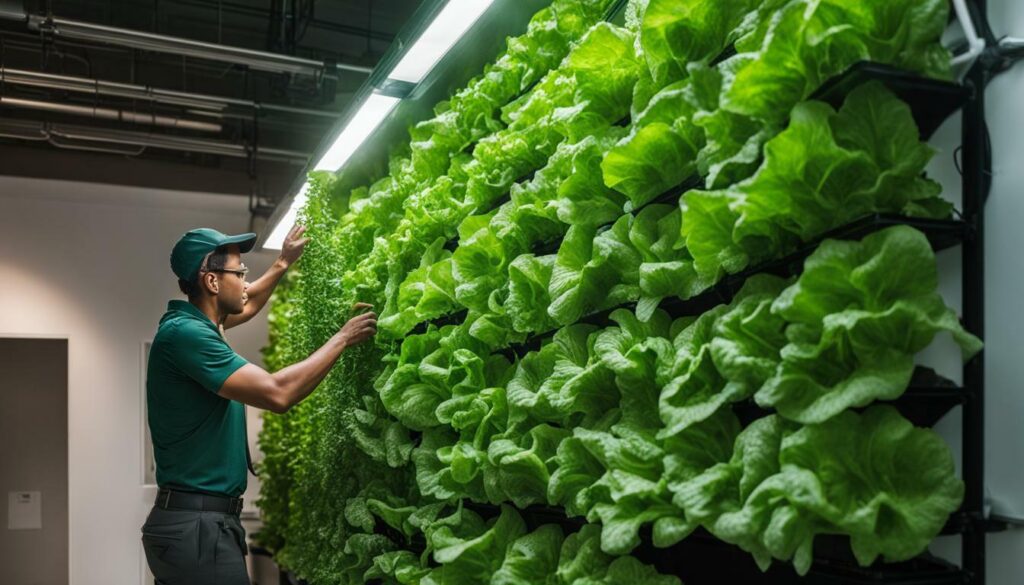
Vertical lettuce gardening offers a space-efficient way to grow lettuce and maximize your garden’s potential. By implementing proper watering and fertilization techniques, practicing effective pest control, and regularly harvesting and pruning your plants, you can create a successful and productive vertical lettuce garden.
Maximizing Space with Vertical Lettuce Gardening
Vertical lettuce gardening offers a practical solution for maximizing your gardening space, allowing you to grow a greater quantity of lettuce plants in a smaller footprint. By utilizing vertical structures such as trellises, vertical garden planters, and stackable planters, you can take advantage of the vertical space in your garden or even create a vertical garden indoors.
One versatile option for vertical gardening is the composting vertical garden planter, which not only allows you to grow up to 50 plants in just four square feet of space but also includes a built-in composter for kitchen scraps. Wall planters with self-watering features provide multiple pockets and baskets for planting a variety of lettuces and herbs, turning any wall into a lush green display. Vertical garden beds, resembling stacked flower boxes, offer the convenience of built-in drip irrigation systems, making gardening easier and more efficient.
When it comes to maximizing space with vertical lettuce gardening, creativity is key. You can repurpose items like old bicycles, wagon wheels, or pieces of fencing to create unique structures for your vertical garden. Branches can be transformed into rustic vertical garden structures like teepees or adorned with chicken wire for climbing plants. These repurposed structures not only serve functional purposes but also add visual appeal to your garden.
The choice of lettuce varieties is crucial for successful vertical gardening. Opt for lettuces with a short root system or those that like to climb, such as radishes, spinach, and basil. Vining plants like cucumbers, cherry tomatoes, and pole beans are also suitable for vertical gardening. The vertical growth of roses can transform a fenceline into a beautiful focal point.
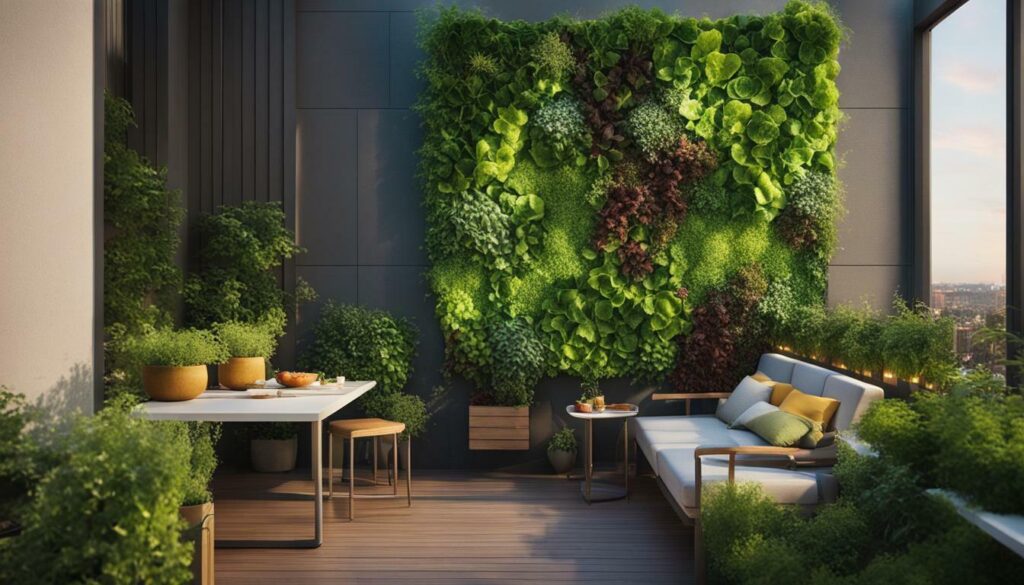
When designing your vertical lettuce garden, consider the structure and materials that will best suit your space. Arbors, trellises, and other supports can be utilized to guide plants upward. Experiment with different materials, such as wood or bamboo, and get creative with repurposed items like old fences or chain-link to add character to your garden.
To ensure successful vertical lettuce gardening, proper care and maintenance are crucial. Adequate watering, fertilization, and pest control strategies should be implemented. Pay attention to the specific needs of your lettuce varieties and ensure they receive the optimal growing conditions.
With vertical lettuce gardening, you can maximize your gardening space and enjoy a bountiful harvest even in limited areas. By thinking vertically, you can transform your space into a lush and productive lettuce garden.
Creative Vertical Lettuce Garden Structures
Take your vertical lettuce garden to the next level by incorporating creative structures and repurposed items to add visual interest and unique design elements to your space. Vertical gardening allows you to maximize the use of limited space and transform your garden into a beautiful and functional oasis. Here are some creative ideas to inspire your vertical lettuce garden design:
- Vertical Garden Planters: Explore the versatility of vertical garden planters, such as composting vertical garden planters or self-watering wall planters. These planters not only provide a space-saving solution for growing lettuce but also add aesthetic appeal to your garden. Imagine having an entire wall of greenery in your house or a wall planter filled with a variety of lettuce varieties.
- Vertical Garden Beds: Consider using vertical garden beds, which are stacked flower boxes placed on a stand or frame. These beds can be made of wood or plastic and may come with drip irrigation systems, making gardening easier and more efficient.
- Stackable Planters: Stackable planters are trays with multiple planting spots that can be stacked to create a tower-like structure. They are perfect for growing lettuce and other plants that thrive in confined spaces. These planters also come with drip trays, allowing you to use them both indoors and outdoors.
- Repurposed Items: Get creative with repurposed items to add a unique touch to your vertical lettuce garden. Consider using old bicycles, antique tillers, wagon wheels, or fences to create trellises and garden structures. These repurposed items not only serve as functional supports but also add a rustic and charming appeal to your garden.
By incorporating these creative structures into your vertical lettuce garden, you can create a visually stunning and efficient space that maximizes your lettuce yield while adding a touch of personality to your outdoor or indoor space.
Vertical Lettuce Garden Design Ideas
In addition to the structures mentioned above, there are various other design ideas that can enhance the aesthetics of your vertical lettuce garden:
- Use arbors and trellises with creative designs to add a structured and visually pleasing element to your garden.
- Repurpose old items like chairs, ladders, or even kitchen utensils to create unique and eye-catching vertical lettuce garden structures.
- Consider incorporating living walls or green walls that feature vertical arrangements of plants, creating a stunning focal point in your space.
Remember to choose the lettuce varieties that are well-suited for vertical gardening, as they tend to have shorter root systems or climbers. Some popular options include lettuce, radishes, spinach, cucumbers, cherry tomatoes, and pole beans.
By combining innovative structures, repurposed items, and creative design ideas, you can create a vertical lettuce garden that not only maximizes your space but also adds beauty and functionality to your outdoor or indoor area.
| Vertical Garden Structure | Benefits |
|---|---|
| Vertical Garden Planters | – Versatile and space-saving – Can have built-in composters or self-watering features |
| Vertical Garden Beds | – Stacked flower boxes – Some come with drip irrigation systems |
| Stackable Planters | – Tray-like structure – Can be stacked to create a tower – Suitable for confined spaces |
| Repurposed Items | – Adds rustic and charming appeal – Utilizes old items creatively |
Conclusion
Embrace the efficiency and versatility of vertical gardening with a Lettuce Grow Vertical Garden, and transform your space into a productive and sustainable oasis of fresh lettuce. Vertical gardening offers a solution for those who have limited space but still want to enjoy the benefits of growing their own food. By utilizing vertical space, you can maximize your garden’s potential and create a stunning display of greenery.
One of the key advantages of vertical gardening is its space-saving nature. With a Lettuce Grow Vertical Garden, you can grow up to 50 plants in just four square feet of space. Whether you have a small balcony, a tiny backyard, or even an indoor area, vertical gardening allows you to make the most out of every inch.
Getting started with a vertical lettuce garden is easier than you might think. Simply choose a suitable location, prepare the soil, and plant your lettuce using the step-by-step instructions provided. With a little effort and care, you’ll be rewarded with a bountiful harvest and the satisfaction of growing your own fresh, nutritious lettuce.
When it comes to choosing the best lettuce varieties for vertical gardens, there are several options to consider. Look for plants with a short root system or ones that like to climb, such as lettuce, radishes, spinach, cucumbers, and cherry tomatoes. These plants thrive in vertical gardens and will provide you with a continuous supply of delicious greens.
Designing your vertical lettuce garden is another exciting aspect of this gardening technique. Explore various design ideas, such as using wall planters, vertical garden beds, or stackable planters. You can even repurpose items like old bicycles, wagon wheels, or fences to create unique and visually appealing structures for your lettuce garden.
To ensure success in vertical lettuce gardening, there are a few tips to keep in mind. Proper watering, fertilization, and pest control are essential for healthy plant growth. Additionally, maximizing space and utilizing vertical structures effectively will help you achieve the best results. With these tips and strategies, you can overcome any challenges and enjoy a thriving vertical lettuce garden.
In conclusion, vertical gardening with a Lettuce Grow Vertical Garden is a game-changer for transforming spaces into productive and sustainable gardens. Whether you have a small urban apartment or a spacious backyard, vertical gardening allows you to grow your own fresh lettuce and make the most of your available space. By following the step-by-step instructions, choosing the right lettuce varieties, and implementing design ideas and tips, you can create a beautiful and thriving vertical lettuce garden. Start your vertical gardening journey today and enjoy the benefits of fresh, homegrown lettuce right outside your door.
Can Lettuce Grow Vertical Garden Be Used to Grow Other Vegetables?
Yes, the growing vegetables vertically truth is that a lettuce grow vertical garden can be used to grow other vegetables as well. Vegetables like spinach, kale, and Swiss chard can thrive in a vertical garden alongside lettuce. It’s a great way to maximize space and increase your vegetable yield.
FAQ
Q: How does vertical gardening maximize space?
A: Vertical gardening allows you to grow plants upward instead of outward, making it possible to take full advantage of limited space.
Q: What are the benefits of vertical lettuce gardening?
A: Vertical lettuce gardening increases yields, reduces plant problems, provides better air circulation, and is easier on your back.
Q: How do I start a vertical lettuce garden?
A: To start a vertical lettuce garden, choose the right location, prepare the soil, and plant the lettuce in a vertical planter or trellis.
Q: What are the best lettuce varieties for vertical gardens?
A: Lettuce varieties that are well-suited for vertical gardens include romaine, butterhead, and loose-leaf lettuce.
Q: How can I design my vertical lettuce garden?
A: You can design your vertical lettuce garden using various planters, trellises, and repurposed items such as old bicycles or fences.
Q: Do you have any tips for successful vertical lettuce gardening?
A: Yes, some tips for successful vertical lettuce gardening include proper watering, fertilization, and pest control.
Q: How does vertical gardening maximize space?
A: Vertical gardening allows you to grow plants upward instead of outward, making it possible to take full advantage of limited space.
Q: What are some creative vertical lettuce garden structures?
A: Some creative vertical lettuce garden structures include living walls, arches, trellises, and pallet gardens.
Q: What is the conclusion of this article?
A: The conclusion of this article is that a Lettuce Grow Vertical Garden can transform spaces and maximize gardening potential, allowing individuals to grow their own fresh produce even in limited areas.

